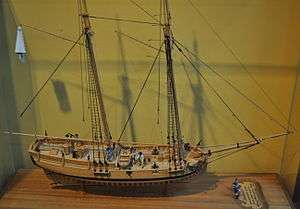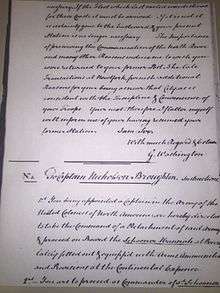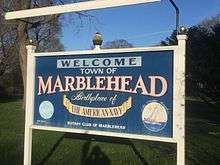USS Hannah
 Model of Hannah in the U.S. Navy Museum | |
| History | |
|---|---|
| Acquired: | 24 August 1775 |
| Commissioned: | 2 September 1775 |
| Decommissioned: | October 1775 |
| Out of service: | 10 October 1775 |
| Fate: | Unknown |
| General characteristics | |
| Tons burthen: | 78 |
| Propulsion: | Sail |
| Armament: | 4 × 4-pounder guns |
The schooner Hannah was the first armed American naval vessel of the American Revolution and is claimed to be the founding vessel of the United States Navy. She was a fishing schooner owned by John Glover of Marblehead, Massachusetts and was named for his daughter, Hannah Glover. The crew was drawn largely from the town of Marblehead, with much of the ships ammunition being stored in Glover's warehouse now located at Glover's Square in Marblehead before being relocated to Beverly, Massachusetts.

Service history
The schooner was hired into the service of the American Continental Army by General George Washington. Washington commissioned Nicholson Broughton to command the Hannah on 2 September 1775 and ordered the vessel to, "...cruize against such vessels as may be found . . . bound inward and outward to and from Boston, in the service of the [British] army, and to take and seize all such vessels, laden with soldiers, arms, ammunition, or provisions . . . which you shall have good reason to suspect are in such service."[1] Hannah set sail from the harbor of Beverly, Massachusetts on 5 September 1775, but fled to the protection of the harbor of Gloucester, Massachusetts two days later under the pursuit of HMS Lively and a second British vessel. Leaving Gloucester Harbor, Hannah captured the British sloop Unity.
Washington's Fleet
Alongside other Marblehead schooners, the Franklin, the Warren, the Hancock, and the Lee, the first Continental navy was assembled on Boston's north shore. Three of the four captains of the ships were residents of Marblehead; John Selman, John Manley, and James Mugford who respectively commanded the Warren, Lee and Franklin during 1775 and into 1776. Along with another Marblehead native and famed naval Captain Samuel Tucker, General Washington's Fleet raided enemy British ships up and down the Massachusetts coast. "With crews of experienced Marblehead seamen, these bold and highly skilled mariners captured enemy supply ships filled with ammunition and armaments that were crucial to the American cause of independence. The fleet was believed to have flown the Revolutionary "Pine Tree Flag" with the less common motto "An Appeal to God" signifying the crews' loyalty to their New England woodlands and their religion.[2] On one of the schooner's first voyages, it encountered the sloop Unity which was owned by John Langdon, a member of the Continental Congress from New Hampshire, but had been taken by the British Royal Navy. Rather than returning the ship to its rightful owner, Captain Broughton sailed the ship to Gloucester and requested he and his crew be given the store of salt fish beef and lumber. Washington's orders were to strictly collect munitions only, and his refusal caused a mutiny among the crew, of whom 14 were ordered whipped, but only one was punished. '.[3]
Hannah's brief naval career ended on 10 October 1775, when she was run aground under the guns of a small American fort near Beverly by the British sloop Nautilus. After a 4 hour engagement between the British ship and Beverly and Salem militias on the shore, Hannah was saved from destruction and capture. The Nautilus was badly damaged, but managed to escape with the rising tide around 8 p.m.. According to the New England Chronicle dated October 12th 1775, "...no lives were lost on our side, and the Privateer [Hannah] was damaged little if any". Other sources however still claim that the Hannah was soon decommissioned as General Washington found more suitable ships for his cruisers.[4]
Fate
According to legend, soon after the Hannah's decommissioning, the schooner was towed to Lee's Wharf in Manchester, where its name was changed to the Lynch. There, the vessel was restored to working condition by 7 carpenters over the course of 3 weeks. In March of 1777, the Lynch was sent to France with congressional correspondence for Benjamin Franklin, who was there was U.S. Ambassador. Upon embarking on their journey back to the U.S., the Lynch and its crew were captured by British ship HMS Foudroyant. The Lynch was sold as a prize by the British and documentation indicates that the schooner was used as a merchant vessel thereafter. Most modern scholars however believe the ship was completely destroyed or at least damaged beyond repair, thus rendering the true fate of the ship unknown. While no imagery of the ship is known to exist, trading and fishing schooners like the model pictured above, as well as those painted below, are commonly thought to be accurate representations.[5]

Legacy
The City of Beverly, Massachusetts and the Town of Marblehead, Massachusetts each claim to have been the home port of the schooner. Each asserted the honor of being "the Birthplace of the American Navy" from the career of the Hannah until a plaque, currently on display in the Selectmen's room at Abbot Hall in Marblehead, was discovered in the Philadelphia Navy Yard proclaiming Marblehead to be the birthplace; Beverly has since reinvented itself as "Washington's Naval Base." Alongside the plaque is a display detailing Marblehead's storied Naval history, especially focusing on the importance of the USS Hannah and the rest of the fleet that became the first of the United States Navy. Similarly, the entrance sign to the town of Marblehead features a small inset of an artist's depiction of the USS Hannah. In June of 1926 the town celebrated the 150th anniversary as birthplace of the Navy. In 1992, the USS Constitution, another important Naval ship that protected Marblehead during the War of 1812, on its final unassisted voyage made a stop in Marblehead Harbor in 1992, before becoming a museum in Boston. One of the original gas stations in the town featured a facsimile piece of the hull of the Hannah pictured below. After the Hannah, Glover refitted five more schooners and personally launched another two from Plymouth. In the coming months though, the Continental Congress recognized the need for a Navy to accompany Washington's Army, smaller private boats such as the Hannah fell out of favor. Along with much of the exhibit in Abbott Hall, the history of the town's involvement in the creation of the world's most powerful Navy has been meticulously reconstructed.[6]
Gallery
See Also
Naval operations in the American Revolutionary War
History of the United States Navy
References
- ↑ "Washington Commission's First naval Officer". massmoments.org. Naval Historical Center. 2012-10-17. Retrieved 2016-05-09.
- ↑ Curatorial staff and exhibits of Abbot Hall, Marblehead, MA
- ↑ Peterson, Pam. "Marblehead 101: Marblehead and the American Revolution: 1775 the Hannah and the American Navy" Accessed at the Marblehead Historical Society and Museum, April 2016.
- ↑ "Washington Commission's First naval Officer". Massmoments.org. Naval Historical Center. 2012-10-17. Retrieved 2016-05-09.
- ↑ Macy, T. (2002). Hannah and the Nautilus: The Beginning of the American Revolution at Sea. Beverly, MA: Beverly Historical Society.
- ↑ Cheri Grishin, Assistant Director of the Marblehead Museum, 170 Washington Street. Marblehead, MA 01945





